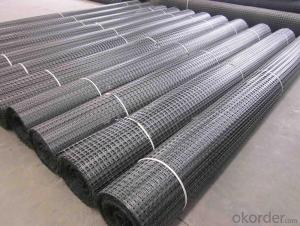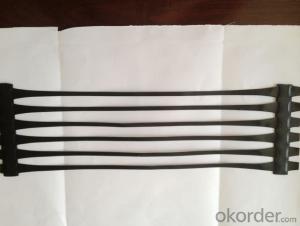HPDE Geocells Biaxial Geogrid for Coal Mine Support
- Loading Port:
- Tianjin
- Payment Terms:
- TT OR LC
- Min Order Qty:
- 88 m²
- Supply Capability:
- 1800000 m²/month
OKorder Service Pledge
OKorder Financial Service
You Might Also Like
Introduction of CNBM
China National Building Materials (Group) Corporation (CNBM) is a state-owned enterprise in charge of administrative affairs in China building materials industry. Established in 1984, CNBM is a large group corporation of building materials with total assets of RMB 25 billion and a total staff of 30,000. Now CNBM owns more than 200 subsidiaries in and abroad the country, including wholly-owned corporations and joint ventures.
FAQ of geosynthetics :
What is geosynthetics ?
Geosynthetics form a perfect erosion control fabric used extremely widely in civil engineering to stabilize and reinforce slopes and soil under or next to roads, railways, dams, water reservoirs etc.. They can be easily applied which minimizes the time of construction, as well as they limit the resources and materials necessary.
What kinds of geosynthetics we have ?
Non-woven geotextile, geogrids, geocells, GCL, Geomembranes, Geonets, Geocomposites etc .
What is the geosynthetics used for ?
Hydraulic
Lagooning and Water Treatment, Ornamental Ponds, Golf Courses
Aquaculture and Desalination,Water Lagoons,Tanks, Reservoirs, Liquid Waste,Floating Cover Solutions, Drainage and Filtration
Environment
Tailing ponds, Leach mining,Landfills,Landfill Capping,Protection against corrosion,Vertical Barriers
Civil Works
Erosion Control,Secondary Containment,Tunnels,Linear and Surface Works,Consolidation of Margins,Soil Reinforcement,Soil Separation.
Building - Parkings,Roofing,Soundproofing
Structure of Biaxial Geogrid ( Biaxial plastix protect-support net used in coal mine ) description :
Double-direction geogrid is made of high molecular polymer through extrusion, forming and punching before longitudinal and lateral stretching. This material has considerable tensile strength in longitudinal and lateral directions. This chain structure can effectively bear and diffuse forces on soil and is applicable to large area permanent load bearing foundation as a reinforce.

Properties of Biaxial Geogrid ( Biaxial plastix protect-support net used in coal mine ):
Homogenous structure, low creepage ,anti-aging and resisting acid and alkaline.
Application of Biaxial Geogrid ( Biaxial plastix protect-support net used in coal mine ) :
Make reinforce treatment for various of soft soil foundation to evenly distribute load stress and reduce unevensettlement , it is easy to wash coal . used in highway ,railway,port,airport, municipacl and projects of supporting in the recovery working face of coal mined and ladeway in the coal mine .
Specification of Biaxial Geogrid ( Biaxial plastix protect-support net used in coal mine ) :
TGSG15-15,TGSG20-20,TGSG25-25,TGSG30-30,TGSG35-35,TGSG40-40,BP15-15MS,HPP20-20MS, HBPP25-25MS,HBPP30-30MS,HBPP35-35MS,HBPP40-40MS
Width : 1M,2M,3M,4M.
Length: 50m,100,
Color: black
Packaging & Delivery of Biaxial Geogrid ( Biaxial plastix protect-support net used in coal mine ): Each roll is wrapped in a woven bag then into container Or Packed as customers' requests.
Production periods of Biaxial geogrid : within 10 days after receiving the deposit
- Q: What are the types of Geogrid
- There are many types of geogrid is about tgsg / convex node tgsg / whole tgsg / glass fiber geogrid
- Q: The amount of geotextile is estimated to be used on both sides of the retaining wall
- Application of Geogrid in soft soil foundation and uneven settlement
- Q: Are geogrids resistant to hydrolysis?
- Yes, geogrids are generally resistant to hydrolysis.
- Q: How do geogrids improve the performance of mechanically stabilized earth walls?
- Geogrids improve the performance of mechanically stabilized earth walls by providing reinforcement and enhancing the stability of the structure. They distribute the applied loads more evenly, reducing potential settling or differential movement. Geogrids also increase the tensile strength and shear resistance of the soil, preventing wall failure and improving overall durability.
- Q: What are the factors that affect the installation and survivability of geogrids in cold climates?
- The factors that affect the installation and survivability of geogrids in cold climates include the ground temperature, frost heave, freeze-thaw cycles, and the type of soil. Cold temperatures can make the installation process challenging as the ground may become frozen, requiring additional measures to thaw the soil for proper installation. Frost heave, which occurs when water in the soil freezes and expands, can impact the stability and effectiveness of geogrids. Freeze-thaw cycles can also cause damage to the geogrids over time. Additionally, the type of soil, particularly its moisture content and drainage characteristics, can influence the performance and durability of geogrids in cold climates.
- Q: Glass fiber grating with large pulling force for Expressway
- Fiberglass geogrid is mainly used for old road reconstruction, the main purpose is to reduce reflection cracks.
- Q: Can geogrids be used in soil reinforcement for pipeline projects?
- Yes, geogrids can be used in soil reinforcement for pipeline projects. Geogrids are commonly used in civil engineering projects to improve soil stability and prevent soil erosion. They are effective in providing reinforcement and reducing the potential for soil settlement, making them suitable for enhancing the stability of pipelines in various soil conditions.
- Q: How do geogrids improve the stability of mechanically stabilized earth walls?
- Geogrids improve the stability of mechanically stabilized earth walls by providing reinforcement and confinement to the soil. They increase the tensile strength of the wall system, redistributing applied loads and preventing excessive deformation. The geogrids also enhance the overall stability by minimizing soil erosion and promoting better compaction, resulting in a more robust and durable structure.
- Q: The geogrid is convenient for construction, time saving, labor saving, shorten the construction period and reduce maintenance cost.
- Fill enough paint to make it smooth.6, removal of leakage of tape. Then, note that all of the cracks have been properly repaired, with a fine composite material will be modified around the repair, so that it is as bright as new.
- Q: How do geogrids improve the performance of geotextile-reinforced slopes?
- Geogrids improve the performance of geotextile-reinforced slopes by providing additional tensile strength and stability. They enhance the overall structural integrity of the slope, preventing soil erosion and reducing the risk of slope failure. The geogrids act as a reinforcement layer, distributing the lateral forces and increasing the load-bearing capacity of the slope. This improves its overall performance and longevity, making it more resistant to external factors such as heavy rainfall or seismic activity.
Send your message to us
HPDE Geocells Biaxial Geogrid for Coal Mine Support
- Loading Port:
- Tianjin
- Payment Terms:
- TT OR LC
- Min Order Qty:
- 88 m²
- Supply Capability:
- 1800000 m²/month
OKorder Service Pledge
OKorder Financial Service
Similar products
Hot products
Hot Searches
Related keywords




























